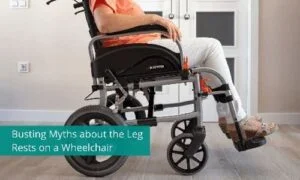Choosing the right legrest for your wheelchair is more than just a matter of comfort—it’s about functionality, accessibility, and remaining sitting position. Whether you’re a new user or upgrading, knowing the different types of legrests can greatly enhance your daily experience. Here’s a five–step guide to help you make an informed choice.
1. Know Your Range of Knee Motion
The range of knee motion is probably one of the most critical measurements in the legrest prescription process. Over-stretched legs are not only uncomfortable but can also lead to poor posture over time.

Reference article: The Fundamental Importance of Knee Range of Motion
- Within Normal Limits (WNL): If knee flexion falls within normal limits, most legrest options should be suitable.
- Fixed Knee Contracture Over 90 Degrees: When knee angles are fixed at over 90 degrees, proper support usually requires specific alignment between seat depth and a customized legrest.
- Limited Knee Flexion or Fixed Knee Contracture: For users with limited knee flexion or fixed contractures, it’s important to choose a legrest that supports the exact angle needed.
-
- Tool-adjustable legrests and manual elevating legrests are the most commonly used options.
- Users with high muscle tone over the knees will benefit from tool-adjustable legrests, as these allow for a stable, fixed position.
- If different limitations exist in each knee, sperated legrests with an independent angle-adjusting function are often the better choice.
2. Consider Your Transfer Method
If you frequently transfer into and out of your wheelchair from its side, it’s essential to choose a legrest that won’t obstruct your movement. Central legrests provide clearance on both sides of the legs, which can be a game-changer for users with limited hand mobility to have smooth transfers.
For those who prefer transferring from the front of the wheelchair, swing away legrests can clear the leg space entirely. However, if a user lacks sufficient hand function to swing the legrest away, consider legrests that allow the footplate to lower to the ground. Paired with anterior tilt or low seat height, this setup enables users to step out of the wheelchair directly from the front.
3. Choose the Right Footplates
Don’t overlook the footplate design when selecting a legrest. Not all footplates are compatible with every legrest, so be sure to consult with your dealer or therapist to ensure the right match.
The central mount footboard is ideal for compact space or indoor if it can be positioned at an angle close to 90 degrees.
For users without any leg deformities, either a one-piece or two-piece footplate is suitable. However, if there is a leg length discrepancy, two-piece footplates are recommended to accommodate different footplate heights on each side.


Adjustable footplate is ideal for individuals with foot deformities, as it can be tilted forward and backward, and the lateral angle can also be adjusted.
Special mention should be made of Amputee Legrests, which typically feature shortened support and angle adjustability. Some models also provide lateral support to help keep the residual limb stable.
4. Think About Leg Elevation Needs
If you have a positioning wheelchair and you have no deformities in your lower extremities, consider whether manual or powered elevating legrests are better suited to your needs and abilities.
To enhance circulation in the lower limbs, a tilt-in-space wheelchair equipped with elevating legrests can be highly effective. The key principle is to position the legs higher than the head, which promotes better blood flow.
Pro Tip: Biomechanical length compensation allows the legrest to adjust in length as the angle changes, reducing strain on the joints. It’s especially important for users who cannot reposition themselves in their wheelchair.
5. Consult Your Therapist for Special Positioning
For individuals with severe deformities in the pelvis, trunk, and lower extremities, a specialized positioning setup is necessary to ensure sitting stability, comfort, and driving efficiency. A therapist’s assessment plays a crucial role in selecting the most suitable legrests to support proper posture.
Conclusion
Choosing the right legrest for your wheelchair is essential for maximizing both comfort and functionality. By taking into account factors such as your range of knee motion, transfer methods, footplate design, leg elevation needs, and specific sitting posture, you can make an informed decision tailored to your individual requirements. If you have further questions about selecting legrests, consulting a qualified therapist and your dealer for professional guidance is key to making the right choice.

Tzuyu Lin, PT, Product Manager
Tzuyu Lin is a physiotherapist and Product Manager at KARMA headquarters. She began her career at the Rehabilitation Engineering Lab at National Taiwan University, focusing on exoskeleton studies, and later gained five years of physiotherapy experience at an orthopedics clinic.
Since joining KARMA in 2021 as a Product Specialist, Tzuyu has focused on custom adaptations and complex rehab technology. Now part of the product management team, she co-developed the KARMA Flexx Adapt wheelchair.
Keep Reading

 Global
Global




